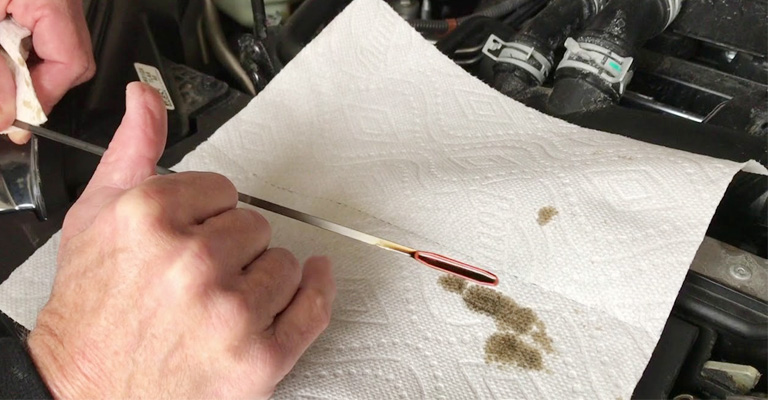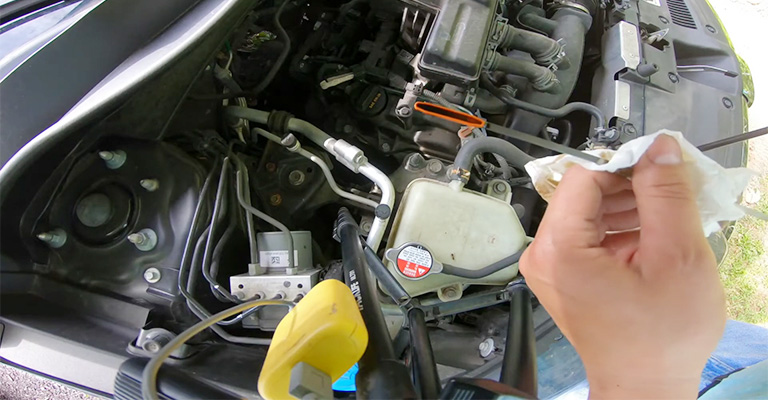Engine oil dilution is a common but serious problem for any car engine. Multiple reasons may play a role in causing engine oil to be diluted by the fuel, and the oil quality deteriorates by this type of contamination.
However, regular maintenance and timely action may prevent our engine oil from this damage.

Despite that, the oil dilution in cars manufactured by Honda has attracted huge attention recently.
This is due to the fact that Honda tried to play ‘smart’ when they manufactured and marketed cars with engines of faulty design, making the problem too hard to solve and trying to hide and deny this fact from the public.
Let’s keep reading about why oil dilution in Honda cars has become so big and how to prevent and fix this repulsive automobile problem.
What Is the Oil Dilution Problem?

Oil dilution occurs when the engine oil gets contaminated and diluted by the fuel, which is an unwanted issue in any car.
In automobile engines, the functional unit is the cylinder where Carnot’s cycle takes place and converts the thermal energy into mechanical energy.
Simply speaking, the fuel or gasoline undergoes combustion inside the cylinder, and the crank wheels start rotating, generating mechanical energy.
The mechanical moving parts of the engine stay dipped into engine oil or lube oil so that they can function without friction and the engine runs smoothly.
However, for several reasons, the gasoline gets leaked into the oil pan chamber, gets mixed with engine oil, and changes the oil property by diluting it, leading to negative impacts on the engine.
This phenomenon is termed oil dilution. Despite being a common problem, this is not what any car owner desires for his car, and car manufacturers continuously strive to overcome this problem while upgrading the design of the engines.
What Causes Oil Dilution?

Engine oil has a certain period of effective service, and it is common for engine oil to experience some dilution.
However, sometimes, the engine oil gets diluted alarmingly due to some factors. The primary reasons for oil dilution can be attributed to the following:
- Cold environment
- Malfunctioning fuel injectors
- Fuel burnt improperly
- Piston rings losing airtightness
- The engine stalled for a long time
- Vehicle stopping too often
- Fuel injection directly
In the extreme cold regions, some unburnt fuel seeps into the oil chamber, bypassing the cold, worn, and shrunken piston rings.
Also, if the vehicle stops few and far between, the engine oil does not have enough time and temperature to get heated and evaporate the leaked fuel, making it diluted.
How Are Honda Cars Suffering from Oil Dilution?

In these cases, the unburnt fuel sticks to the interior of the cylinder wall and later leaks through the piston rings and gets mixed with the oil in the engine oil chamber, diluting it badly.
Loss of Viscosity
Most commonly, the oil’s viscosity deteriorates when the dilution is at least 2.4% due to gasoline contamination. And 3.4% due to diesel contamination, consequently damaging the lubricating property of the oil.
Flashpoint Reduction
Another severe effect is the reduction of the flash point of the engine oil. As we know, the flash point is the temperature at which the oil catches fire.
The oil dilution causes the flash point to decrease significantly, increasing the risk of the engine catching fire catastrophically.
Which Honda CRV Has the Oil Dilution Problem?
In recent years, Honda has invested significantly and manufactured and launched a new design of engines in their 2017-18 CRVs and 2016-18 Civics.
These models have been showing oil dilution problems. According to Honda, the design of these is intended for maximum fuel efficiency of the 1.5L Turbo engine and avoiding heat loss during the fuel injection.
Unfamiliar Engine Design

Instead of the traditional design involving indirect fuel injection by preparing vaporized air-fuel mixture beforehand, the new design does not deal with any such mixture.
On the contrary, the gasoline is highly pressurized and sprayed into the combustion chamber directly, also known as gasoline direct injection (GDI).
GDI: The Main Culprit Behind Unusual Oil Dilution in Honda Cars
The gasoline accumulates in the cylinder’s inner walls and later moves to the crankcase and oil pan due to being pushed by the pistons and mixing with the engine oil.
If the engine runs at the operating temperature, the heat can vaporize away the contaminating fuel mixed with the oil; however, if the contamination rate is more than the vaporizing rate, which is significantly evident in the Honda 1.5L Turbo engines.
The oil dilution lingers and continues to increase and worsen the existing engine oil contamination.
Honda Oil Dilution: How Serious Is This Problem?
In a brand-new Honda 1.5L Turbo engine, the consequences of oil dilution are no less severe than in a traditional faulty engine with worn-out piston rings.
The reason is, due to the new design, the manufacturers of the 1.5L turbo engine have made it more difficult for the engine to go through self-recovery.
This is by evaporating the diluting gasoline or easy repair by replacing piston rings.
Liquid Gasoline Injection: Accumulation of Fuel
First of all, the engine is injected with ‘liquid’ gasoline which does not help with the recovery process but instead plays the role of thickening the gasoline layer on the cylinder wall.
Lower Operating Temperature Makes It Worse
Later on, the operating temperature is not high enough for the engine to burn off this fuel making its way into the oil chamber.
Car Cabins Get Filled with Unhealthy Gasoline Odor
The Honda owners have filed numerous complaints of the car cabin being filled with strong gasoline odor, making the drivers dizzy.
Oil Property Changes and Degrades
The excessive oil dilution in this 1.5L Turbo engine degrades the oil’s viscosity and other basic properties.
The oil is originally designed to protect the engine from wear and tear, but with this severe contamination and degradation of the oil quality, the engine becomes highly vulnerable to mechanical damage.
Engine Condition Deteriorates Severely
With the dilution exceeding the safety limit, the engine starts to misfire and becomes prone to catastrophic damage and getting stalled in the cold weather.
What Is Honda’s Plan for CR-V and Civic Oil Dilution?
Following the complaints and lawsuits from thousands of Honda owners and drivers who have been experiencing unusual and excessive oil dilution in their prized cars, Honda has taken some steps to rectify the mistake they have made.
Extension of Warranty
They have declared and executed a powertrain warranty of up to six years starting from the date of purchase without any specific mileage limitation.
The major issues the warranty covers are software updates, fresh oil changes, and spark plug replacements.
Software Update of the Car System
Honda claims that a software update solves the oil dilution problem by reducing the time required for engine warming, reducing the probability of accumulated unburned gasoline in the cylinder, and improving the transmission control to stabilize the temperature.
Honda CR-V Oil Dilution? Should I Buy the Car?
Since the oil dilution of the Honda CRV for 2017-18 and Civic for 2016-18 is not like any other models or any other type of usual oil dilution, it is highly recommended that customers think twice before planning to buy these cars.
Car Models with Traditional Engines Do Not Have Oil Dilution Problems So Severe
Other models are usually equipped with traditional engines, even though they are less efficient; at least, we can say that their design itself does not cause oil dilution.
Perhaps some spark plug replacement or piston ring replacement would solve the problems for those cases.
Honda Crv and Civics Have Faulty Engines
But when we are discussing these Honda CRVs and Civics, we have to keep in mind that the manufacturers changed the design for the sake of ‘efficiency’ and made it a gasoline direct injection type, and this design itself is the sole reason for the oil dilution problem getting so bad.
The GDI-Caused Oil Dilution Cannot Be Fixed
We cannot just change the engine design in our cars to fix the problem. No matter how much we apply the ‘band-aid’ solutions proposed by Honda, eventually, the engine will get severely damaged.
How to Fix Oil Dilution?
Unlike exceptional cases such as the Honda 1.5L Turbo engines, avoiding and fixing the oil dilution problem in cars is not too difficult.
Checking the Oil Level
The dipstick of the oil chamber should be checked regularly to see whether the oil level is crossing the upper level, indicating the oil dilution.
Inspecting the Oil Smell
Also, the smell of gasoline indicates oil dilution when the engine is running. The worst possible combination that can cause oil dilution is driving in cold weather, cars stopping frequently, and driving frequent short distances. Plus, a defective radiator that cools the engine too often.
Flush, Replace, and Use Synthetic Oil
Therefore, engine oil needs to be flushed and replaced regularly by high-quality synthetic oil.
Long Distance and Highway Driving
The car should be driven at a considerable long distance to burn off any gasoline mixed with the engine oil, just in case.
Maintenance of Parts and Components
The thermostat should be checked regularly; the same goes for fuel injectors, spark plugs, and piston rings. All these should be maintained and replaced whenever necessary.
Frequently asked questions
Yes, lots of highway driving causes less wear on car engines, and the engine oil gets higher longevity than it would get for city driving.
It is recommended to flush and change the engine oil at least twice a year, even if the car is not driven much.
Dilution caused by accumulated and unburnt fuel and coolant leaks may cause the oil level to increase.
Final Note
Although unwanted, oil dilution is not a problem that cannot be solved. Following some small but useful tips and tricks can help us avoid the oil dilution problem in our cars.
And for the case of Honda cars having an unusual oil dilution issue actually serves as an eye-opener for car enthusiasts.
Therefore, all should know about the functionality of car engines and other components. So that even in cases of previously unknown or unheard designs, one can immediately understand what can go wrong in those cases.

Leave a Reply